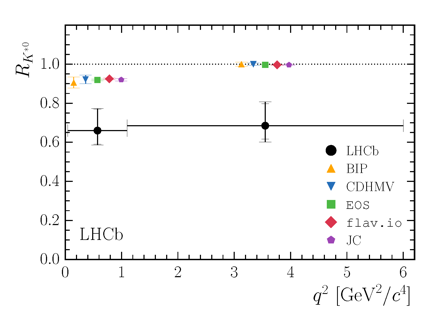LHCb finds new hints of possible deviations from the Standard Model.

Today, at a seminar at CERN, the LHCb collaboration presented results on the measurement of RK*0, which is the ratio of the probabilities that a B0 meson decays to K*0μ+μ– and to K*0e+e–. The K*0 meson was reconstructed through its decay into a charged kaon K+ and a pion π–. This measurement provides an important test of lepton universality (LU), which is one of the most important ingredients of the Standard Model of particle physics. LU means that leptons (e.g., electrons e and muons μ) behave in the same way, i.e., they have the same couplings to gauge bosons.
According to the SM, therefore, RK*0 is expected to be close to unity (small, well-understood effects related to the masses of the leptons prevent the parameter being exactly this value). In the LHCb measurement, the distance of the result from the SM prediction is found to be significant at the level of 2.1-2.5 standard deviations in each of the two regions of q2 (the μ+μ– or e+e– invariant mass squared, see text below) in which the measurement is performed.
Any conclusive observation of LU violation would indicate the existence of physics beyond the Standard Model (BSM). Searches for BSM physics are listed among the most important goals of the LHC physics programme. The B0→K*0μ+μ– and B0→K*0e+e– decay rates could be affected by the presence of so-called heavy “virtual” BSM particles, which couple differently to electrons and muons than the gauge bosons, and therefore could sizeably increase or decrease the rate of the K*0μ+μ– and K*0e+e– final states, resulting in a deviation of RK*0 from the SM prediction.
The image shows the measured value of RK*0 in two regions ([0.045, 1.1], [1.1, 6.0] GeV2/c4) of the μ+μ– or e+e– invariant mass squared, q2. The numerical values are given at the top of the article, where the first uncertainty, which dominates, is statistical, and the second is systematic. The lower boundary of the low-q2 region roughly corresponds to the di-muon production threshold. The 6 GeV2/c4 upper boundary is chosen to reduce a possible contamination from the J/ψ particle. The image also shows several independent SM theoretical predictions. A difference from the SM of 2.1-2.3 standard deviations is observed in the low-q2 region and of 2.4-2.5 in the high-q2 interval. These differences are not yet at the level where they can be claimed to exhibit evidence for BSM physics, but they are intriguing when considered in the context of an earlier LHCb analysis.
In fact a previous LHCb measurement of the quantity RK in which the B0 meson is replaced by a B+ and the K*0 meson by a K+ in the ratio, was also found to have a similar value and be lower than unity by 2.6 standard deviations. This result created much interest in the particle physics community.
What kind of BSM physics could explain the LHCb results? Examples are shown in the Feynman diagrams below. The upper ones show the SM contributions. The left-lower one shows a possible contribution from a heavy Z-boson-like particle, named Z’, which would interact differently with muons and electrons. The lower-right diagram shows a possible contribution from a hypothetical scalar leptoquark LQ, which would interact with both quarks and leptons. Alternatively, different, not yet predicted, and therefore even more interesting, BSM physics could be at play!
The LHCb collaboration has a wide programme of LU tests based on different R measurements in which other particles replace the K*0 or K+ mesons in the ratios. The RK*0 and RK measurements discussed here are obtained using the entire Run 1 data sample corresponding to an integrated luminosity of 3fb-1 at the LHC centre-of-mass energies of 7 and 8 TeV. Data collected in Run 2 already provide a sample twice as large, and it will be of great importance to see whether updates of the present analysis will confirm the discrepancy. In addition, another class of measurements concerning different ratios of B-meson decay rates involving τs and μs, also exhibit some tensions with the SM predictions. Future LHCb measurements will be able to elucidate whether these tantalising hints are a manifestation of statistical fluctuations or whether LHCb is observing a glimpse of new physics.
More information can be found in the LHCb seminar and in the LHCb paper. Read more in the CERN update for the public both in English and in French, in the CERN Courier article, in the Nature news and also in the Symmetry magazine.


